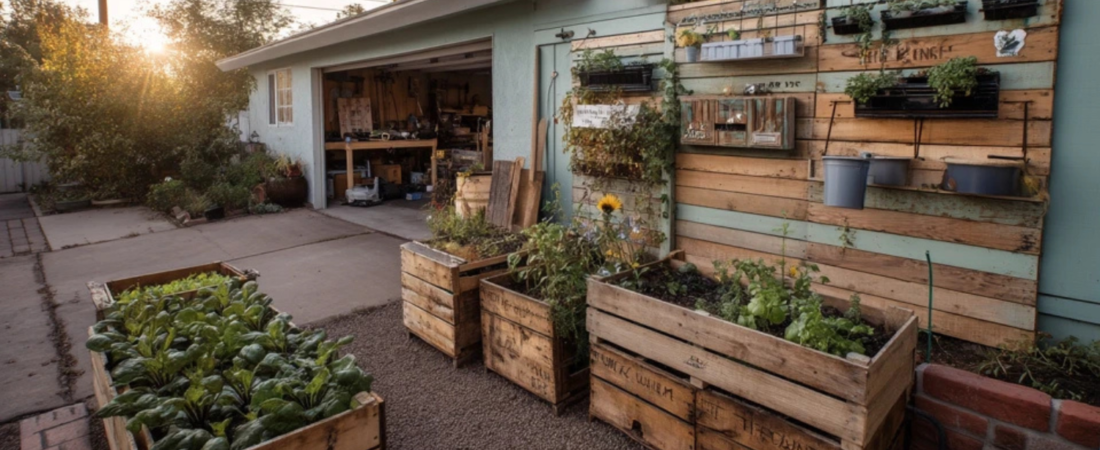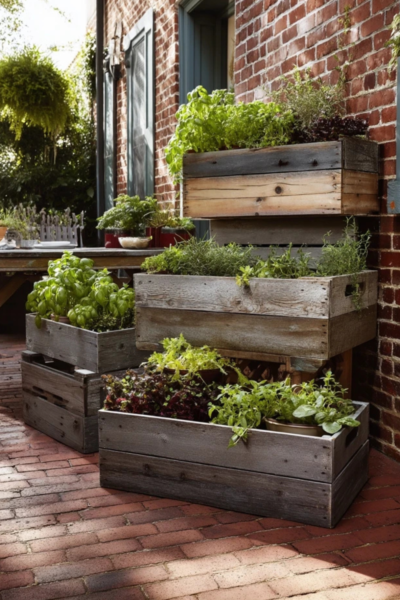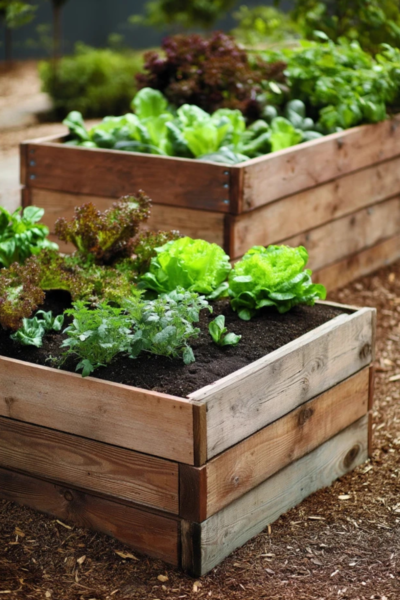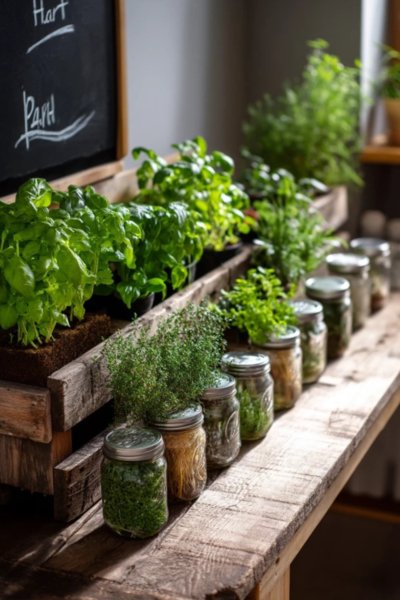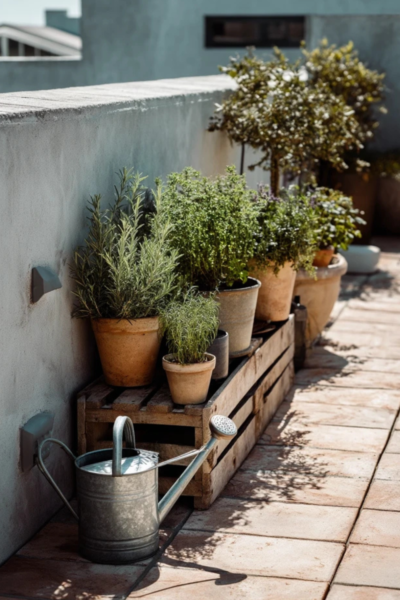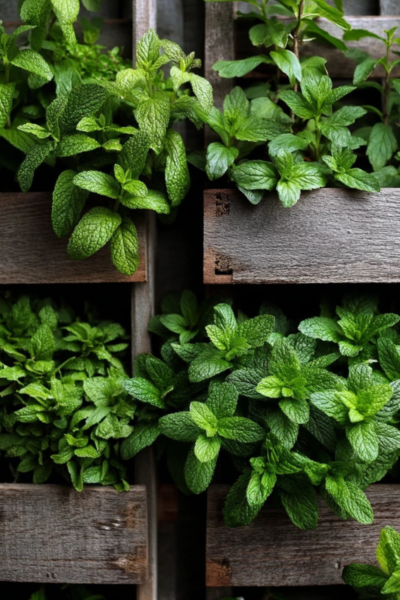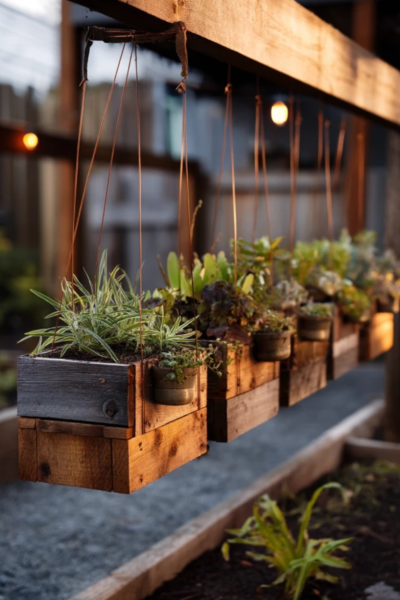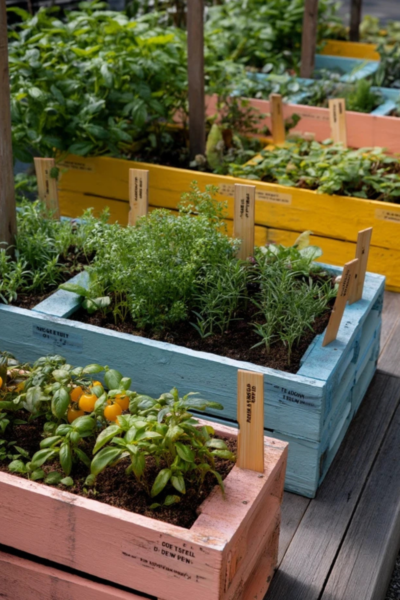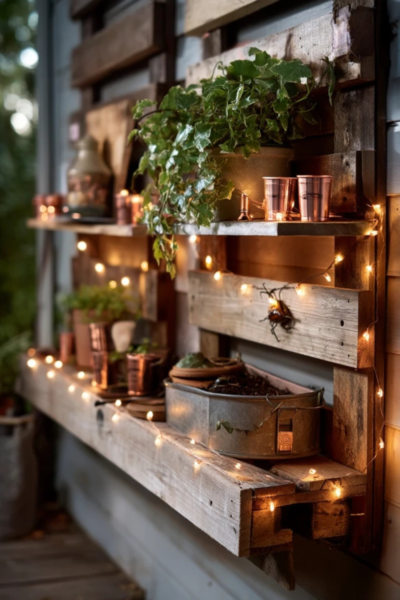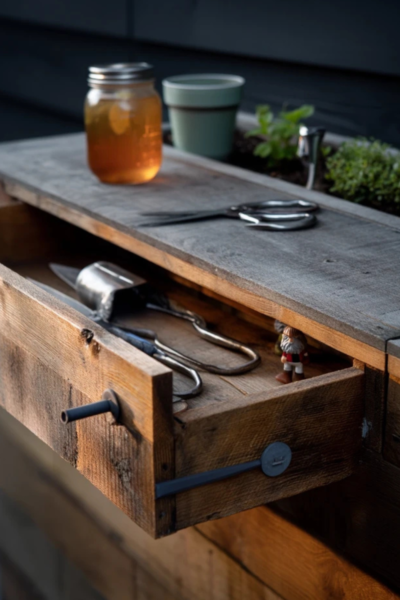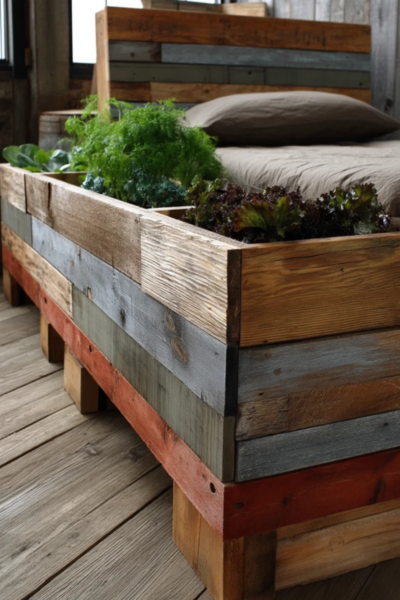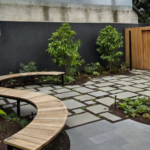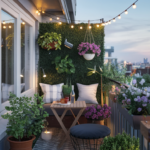I didn’t mean to start a pallet garden. I swear.
It all began with one single wooden pallet I found leaning behind a grocery store like it had just been dumped there by a raccoon with commitment issues. And next thing I know—I’m knee deep in pallet garden boxes, plotting out a vertical garden design, Googling pallet herb garden tips at 2 a.m., and wondering if I could build an entire vegetable garden bed without accidentally constructing a small wooden shrine to my indecisiveness. Spoiler: you absolutely can.
Here’s the deal. If you’ve ever said “oh I could do that” while scrolling past someone’s cute pallet raised garden bed, this is for you. And if you’ve never touched a drill but somehow now own twelve because “they were on sale,” then yep, same. From cheap garden ideas that are somehow still cute to DIY garden projects that don’t involve power tools designed by demons, we’re covering all of it.
I’ve been through every pallet phase:
- The what am I even doing phase
- The maybe I’m good at this phase
- The why does everything smell like stain and regret phase
- And the look at my backyard I’m basically a woodland witch now phase
And now I’m here, shoving my way through the mess to share all the pallet garden ideas DIY fans like me need. This is the blog I wish I had when I thought using wooden pallets for gardening was gonna be a weekend hobby. Cute. So cute.
Now if you’re ready to feel weirdly powerful while hauling splintery boards across your yard like a homesteading goddess (minus the goats), let’s get into the weirdly addictive, kinda magical chaos of pallet gardening.
Pallet Garden Boxes
Line ’em or lose ’em
Here’s what no one tells you when you start a pallet garden: pallets leak like your emotional stability during finals week. Without liners, all that beautiful soil you just spent 20 minutes mixing like it was cake batter? Gone. Right through the cracks. You’ll blink and your pallet garden boxes are just wood skeletons surrounded by sad dirt puddles.
You can use landscape fabric, plastic bags with drainage poked in (classy), or old shower curtains if you’re feeling extra janky. Just line the thing. It’s the one thing you don’t want to skip unless you like watching gravity work in real time.
Stacking strategies for maximum drama
Stacking pallet garden boxes isn’t just practical. It’s also how you assert dominance over your backyard. You wanna say I care about airflow and aesthetics without saying it? Stack those suckers like wooden lasagna. Alternate heights, stagger them like stairs, or lean them at just enough of an angle that they look intentional but still slightly off because you eyeballed it.
Stacking helps with:
- More sunlight for each box
- Easier watering
- No bending over like a garden goblin
- Feeling like you engineered a skyscraper (out of garbage wood, but still)
Painting your boxes without looking like a toddler did it
This one gets personal. I once “distressed” a pallet garden box so hard it looked like it had survived a bar fight. Twice. Don’t be me.
If you’re painting, you need to:
- Sand it first (I know, I’m annoyed too)
- Use a paint made for outdoors, or it’s gonna peel faster than bad sunburn
- Keep it neutral or go full chaos with colors that scream “I have taste, probably”
Also, please paint in one direction unless you want brushstroke art that doubles as a Rorschach test.
When your boxes double as tiny raised beds
Raise your hand if you made a pallet garden box and then realized… this thing’s basically a pallet raised garden bed.
And honestly? Iconic.
You get all the benefits—less weeding, fewer pests, more visual structure—without building a full garden frame. Just stack a couple pallets deep, fill it like a lasagna tray, and boom. Lazy genius.
Bonus: they’re perfect for stuff like lettuce, strawberries, or anything you wanna grow without getting on your knees in the dirt like a 1700s peasant.
Pallet Herb Garden
Herbs that actually grow in pallets
Spoiler alert: not every herb wants to live in a wooden slatted box that used to carry drywall. But some herbs are chill and will thrive in a pallet herb garden like they’re made for it.
The MVPs:
- Basil (lives for sun, drama, and overwatering)
- Thyme (tiny, cute, surprisingly hardy)
- Oregano (basically a weed, in the best way)
- Parsley (it’ll try to die but hang in there)
Avoid stuff that needs deep roots unless you like disappointment. Looking at you, cilantro.
The sun situation: rooftop vibes vs. shady alley regrets
Your pallet garden needs sunlight. Like a lot of it. But depending where you set it up—your plants might be living their best rooftop lives or suffering in your sad, shaded side yard next to the trash bins.
Full sun is ideal for herbs. Think 6 hours of light minimum.
Partial sun might work for mint and parsley but honestly, even they throw shade if they don’t get enough.
And if you’re working with zero sunlight, maybe look into moss. Or therapy.
Keeping mint from taking over the zip code
Mint is aggressive. Not like “oh she’s bold” aggressive. Like I will take over your entire yard and ruin your friendships aggressive.
If you’re planting mint in a pallet herb garden, do not give it free rein.
Best practices:
- Keep it in a container inside your pallet
- Trim often or it’ll spread through every slat
- Don’t fall for its innocent smell. It’s plotting things.
Also—peppermint and spearmint are different vibes. One is for tea. The other is for chaos. Your call.
DIY watering hacks that won’t turn your herbs into mush
Watering your pallet herb garden sounds easy until everything’s either bone dry or a swamp.
I tried one of those upside-down water bottle things and forgot about it. My rosemary drowned.
Here’s what actually helps:
- Line your pallets well (back to that whole liner thing again)
- Water from the bottom if you can—herbs hate soggy roots
- Use mulch to keep things moist without overdoing it
- Schedule watering and stick to it like you’re pretending to be organized
And if you’re feeling wild—stick a finger in the soil. If it feels like a wrung-out sponge, you’re good. If it feels like a desert or a bog, maybe start over.
Vertical Garden Design
Wall-mounted pallets that don’t randomly fall down at 3 a.m.
Building a vertical pallet garden seems like a great idea—until it’s 3 a.m. and it sounds like your backyard is being attacked by raccoons with power tools. Securing your pallet garden to an actual wall is not just smart, it’s survival.
Use anchors, brackets, zip ties, or even chains if you’re feeling unnecessarily hardcore. And check the weight. Wet soil plus planters plus your unrealistic expectations equals this thing is heavier than it looks.
If you’ve got stucco, brick, or a rented wall with landlord rage potential, lean the pallet at an angle instead. Less risk, more sanity.
Hanging planters made from your ex’s leftover wood pile
You know what’s better than closure? Turning something useless into a vertical garden design. A.K.A. revenge decor.
Hanging planters made from leftover pallet scraps are weirdly charming, a little chaotic, and super satisfying to build. You can:
- Suspend them from a top beam
- Nail small boxes into the slats
- Let herbs dangle like nature’s chandeliers
Add hooks or metal loops if you’re fancy. Or don’t. It’s a pallet garden—not a Versailles greenhouse.
Flowers vs. vegetables in vertical setups (pick your battles)
This is where people start getting brave. You think I can grow tomatoes in a pallet nailed to a wall and then nature reminds you she has opinions.
Here’s the general rundown:
- Flowers: Ideal. Most don’t need deep roots and are way less needy.
- Herbs: Sure. They’re chill.
- Vegetables: Ehh. Unless we’re talking leafy greens or strawberries, maybe rethink. Root veggies are a big nope. Peppers could go either way.
The short version? Vertical garden design favors beauty over bulk. Use it to flex your floral aesthetic or show off your plant parenting skills on Instagram. Just not for zucchini. Zucchini will betray you.
Trellis-like pallets and the vine drama they bring
Pallets double as trellises and I gotta say—the drama. You haven’t seen chaos until a cucumber vine decides it’s in charge now.
When using pallets as trellises:
- Make sure it’s anchored well or your pallet garden will flop like a sad puppet
- Choose vines that are light enough not to rip it apart
- Consider morning glories, peas, sweet peas, or even baby squash
Vines get clingy. Real fast. One day it’s twirling around your pallet, the next it’s scaling your fence and heading for your neighbor’s satellite dish.
Pallet Garden Ideas DIY
The TikTok version vs. the real-life version (and how not to cry)
The pallet garden ideas DIY corner of the internet is filled with lies. I’ve seen people build magazine-worthy setups in a tank top with perfect hair and somehow not covered in sawdust or rage. Lies.
Real-life looks more like:
- Splinters
- Uneven wood cuts
- Dirt in places dirt shouldn’t be
- Questioning your life choices at least twice
But it’s still worth it. It just takes actual time, patience, and probably a do-over. Or five.
Weird tools you’ll suddenly become emotionally attached to
You think you’re not a tool person until you meet the one. For me it was this mini crowbar I named Barry. Changed my life.
When diving into DIY pallet garden projects, you’ll find tools like:
- Staple guns (dangerous, fun, slightly scary)
- Electric sanders (aka the dusty dance machines)
- Pry bars (for breaking pallets down like a beast)
- Gardening scissors that make you feel like a plant surgeon
And yes—you will start having favorites. And yes, you’ll panic if one goes missing.
Color-coding plants because you’re that organized now
You start out thinking a pallet is a pallet and suddenly you’re matching soil types with paint swatches and arranging herbs in rainbow order like a garden-loving librarian.
Color coding helps with:
- Quick identification
- Aesthetic joy
- Pretending your pallet garden has a system even if you don’t
Use plant tags, chalk paint on slats, or go bold with entire planter rows in different shades. Also makes you look like you know what you’re doing. Even if you deeply do not.
Cheap add-ons that look like you spent money you didn’t have
Want to make your DIY pallet garden look bougie on a budget? Add ridiculous little upgrades that make people go “oh wow” while you’re quietly giggling.
Try:
- Solar lights tucked in between the slats
- Copper plant markers (spray-painted popsicle sticks work too)
- Rope handles on the sides
- Tiny shelves that hold nothing but still impress people
The goal is to make it look intentional and elevated while spending literal pocket change. Also it gives you something to brag about. Which, let’s be honest, is part of the fun.
Pallet Raised Garden Bed
Making them deep enough for carrots and your gardening trauma
Carrots are like that friend who says they’re low-maintenance but actually requires emotional support, daily. Your pallet raised garden bed needs to be at least 12 inches deep if you’re planning on growing anything more dramatic than lettuce. Otherwise, those poor little root veggies are gonna end up stunted and bitter. Just like your last attempt at sourdough.
Stack multiple pallet frames, layer them with good soil, and if you’re feeling brave—throw in some compost. Not the science project from your fridge drawer. Actual compost.
Beds for veggies, flowers, or whatever the squirrels haven’t found yet
Pallet raised garden beds are like open invitations. For you, for your plants, and unfortunately for your neighborhood squirrel mafia. But you’ve got options:
- Veggies: tomatoes, peppers, radishes (all love raised beds)
- Flowers: marigolds, nasturtiums, and zinnias make you look fancy
- Combo beds: herbs in the corners, veggies in the middle, chaos all around
The key is planting what makes you happy and pretending you don’t see the squirrel doing backflips off your garden fence.
Sideboard add-ons for tools, drinks, or decorative gnomes
If your pallet raised garden bed doesn’t include a sideboard for iced coffee and one of those cute little spades, are you even living? Sideboards are easy add-ons—just nail an extra board across the top or attach a little ledge.
They’re great for:
- Holding garden tools
- Serving as a pretend bar cart (priorities)
- Hosting a colony of mini ceramic gnomes who silently judge your weeding skills
Functional? Yes. Necessary? Debatable. Will you love it? Absolutely.
When to use full pallets vs. Frankenstein’d wood bits
Sometimes you’ve got a full pallet ready to go. Other times you’re cobbling together scraps like you’re starring in the low-budget version of a home reno show.
Use full pallets when:
- You want consistency
- The structural integrity matters (like raised beds that hold actual weight)
Go Frankenstein style when:
- You have random wood and delusions of grandeur
- You want a rustic look without paying for it
- You enjoy puzzling and power tools more than therapy
Either way, just be prepared for splinters and a mild identity crisis halfway through.
DIY Garden Projects
Upcycled pallets vs. paying $12 for “distressed” wood (don’t)
Buying “distressed” wood is the home improvement equivalent of buying pre-ripped jeans. You could just do it yourself. You’ve got wood pallets, you’ve got a hammer, and you’ve got vibes.
Upcycling gives you:
- Authentic weird stains and scratches
- The chance to feel smug about your resourcefulness
- The satisfaction of spending zero dollars while looking like you spent forty
And let’s be real, distressing it yourself is mostly just hitting it with tools until it cries a little.
Paint colors that scream “green thumb” and not “crime scene”
Your DIY garden projects need paint that says I’m here to plant things, not I’m here to dispose of something shady.
Choose wisely:
- Sage green: Nature’s neutral
- Terracotta: For when you’re feeling rustic
- Dusty blue: Because it’s pretty and looks great in sunlight
- Anything neon: If your garden’s in Vegas or you’re just really confident
Skip reds that look too much like spilled something. Or glossy blacks. Unless you want your garden to look like a vampire’s backyard.
Combining pallets with other junk you’ve been hoarding “just in case”
This is where your stash of broken chairs, cracked flowerpots, and that rusty wire basket comes in. Mix it all with your pallet garden for DIY glory.
Stuff that weirdly works:
- Old ladders as plant stands
- Window frames with no glass = vertical display
- Crates stacked sideways = garden shelving
- Random hooks for hanging garden tools or mood swings
You’re not hoarding. You’re prepping. Pinterest board in human form.
Fast weekend builds that’ll impress everyone but your cat
Let’s be honest. Your cat’s gonna hate it no matter what. But these quick DIY garden projects will still give you bragging rights:
- Mini vertical herb wall
- Pallet coffee table with potted plants inset
- Raised garden edge made from split pallets
- Planter bench that holds you and your gardening trauma
Fast builds. Big impact. No cat approval necessary.
Conclusion
I didn’t think one busted pallet behind a grocery store would lead to a full-blown pallet garden obsession, but here we are. Covered in soil, surrounded by gnome sideboards, and somehow emotionally attached to a crowbar named Barry. From pallet garden boxes that hold your lettuce and your last shred of sanity, to vertical garden designs that maybe fall once, maybe twice—this whole thing’s one chaotic, deeply satisfying ride.
You’ve got your pallet herb garden thriving in the sun (or stubbornly trying in the shade), your DIY garden projects built from whatever you had lying around, and your pallet raised garden bed probably deeper than most conversations I’ve had this week. It’s scrappy. It’s oddly pretty. It smells like tomatoes and sawdust. And it works.
If you’re like me—messy, sarcastic, slightly overwhelmed but very enthusiastic—you’re already halfway there. The rest is just hauling wood around the yard and pretending you planned it that way. Welcome to the wild, wonky world of pallet gardening. It’s unhinged. And kind of perfect.

